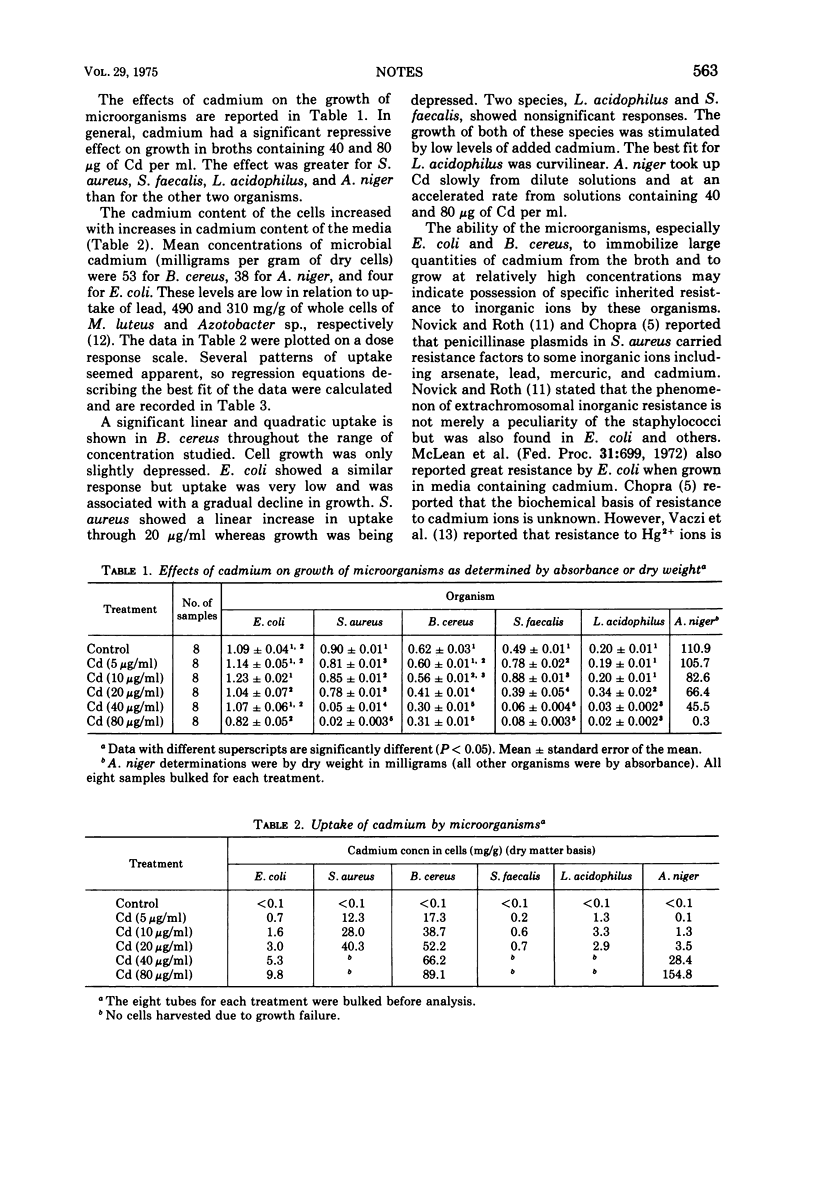Abstract
Six species of microorganisms, Escherichia coli, Bacillus cereus, Lactobacillus acidophilus, Staphylococcus aureus, Streptococcus faecalis and Actinomyces niger, were grown under suitable conditions in appropriate media. Cadmium chloride was added to provide 0, 5, 10, 20, 40, and 80 μg of Cd per ml. At 40 and 80 μg of Cd per ml. E. coli and B. cereus grew well and the other species were repressed. Cd uptake patterns differed significantly among the species tested. The significance of these data with respect to Cd in food chains is discussed.
Full text
PDF


Selected References
These references are in PubMed. This may not be the complete list of references from this article.
- ALTENBERN R. A., WILLIAMS D. R., GINOZA H. S. Effect of cobalt on population changes in Brucella abortus. J Bacteriol. 1959 Apr;77(4):509–509. doi: 10.1128/jb.77.4.509-509.1959. [DOI] [PMC free article] [PubMed] [Google Scholar]
- BOWEN V. T., RUBINSON A. C. Uptake of lanthanum by a yeast. Nature. 1951 Jun 23;167(4260):1032–1032. doi: 10.1038/1671032a0. [DOI] [PubMed] [Google Scholar]
- Chopra I. Decreased uptake of cadmium by a resistant strain of Staphylococcus aureus. J Gen Microbiol. 1970 Oct;63(2):265–267. doi: 10.1099/00221287-63-2-265. [DOI] [PubMed] [Google Scholar]
- Fleischer M., Sarofim A. F., Fassett D. W., Hammond P., Shacklette H. T., Nisbet I. C., Epstein S. Environmental impact of cadmium: a review by the Panel on Hazardous Trace Substances. Environ Health Perspect. 1974 May;7:253–323. doi: 10.1289/ehp.747253. [DOI] [PMC free article] [PubMed] [Google Scholar]
- Luckey M., Pollack J. R., Wayne R., Ames B. N., Neilands J. B. Iron uptake in Salmonella typhimurium: utilization of exogenous siderochromes as iron carriers. J Bacteriol. 1972 Sep;111(3):731–738. doi: 10.1128/jb.111.3.731-738.1972. [DOI] [PMC free article] [PubMed] [Google Scholar]
- Novick R. P., Roth C. Plasmid-linked resistance to inorganic salts in Staphylococcus aureus. J Bacteriol. 1968 Apr;95(4):1335–1342. doi: 10.1128/jb.95.4.1335-1342.1968. [DOI] [PMC free article] [PubMed] [Google Scholar]
- Tornabene T. G., Edwards H. W. Microbial uptake of lead. Science. 1972 Jun 23;176(4041):1334–1335. doi: 10.1126/science.176.4041.1334. [DOI] [PubMed] [Google Scholar]
- VACZI L., FODOR M., MILCH H., RETHY A. Studies on the mercuric chloride resistance of Staphylococcus aureus. Acta Microbiol Acad Sci Hung. 1962;9:81–87. [PubMed] [Google Scholar]


